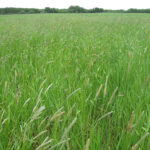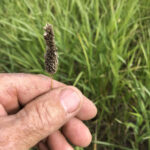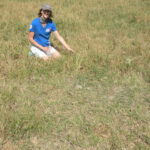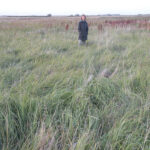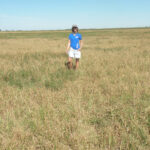Creeping Foxtail
Alopecurus arundinaceus
General Description
Creeping foxtail is a long-lived, early maturing, rhizomatous grass. It is highly adapted to moist riparian areas, but can become invasive due to its longevity, prolific seed production, ease of seed spread (wind/water) and creeping ability.
Creeping foxtail stems can grow to 1 m tall (3.3 ft), with leaves up stems. Leaves are smooth on top and rough beneath. They are generally 6-12 mm wide. The creeping rhizomes are very extensive and can form a thick sod quickly. As a sod thickens, generally less seed heads are produced. Creeping foxtail heads are a similar shape to timothy. The seeds are black and hairy when mature, and can be transported to a new location by wind or water.
Meadow foxtail is a similar species, but does not have creeping roots and seeds are generally light grey in colour. The two species can cross.
Type
Tame grass.
Origin
Eastern Europe, Eurasia.
Longevity
At least 20 years.
Use
Hay, pasture.
Optimal Time of Use
Spring, summer. Creeping foxtail can be continually or rotationally grazed but responds best to rotational grazing. Intense, small paddock grazing may be needed to force grazing. Creeping foxtail begins growth very early in the season. Hay creeping foxtail early, before flowering for the best yield and quality. Over maturity decreasing palatability is a big limitation of creeping foxtail.
Recovery After Use
Requires a minimum 45-60 days of recovery after use. Creeping foxtail regrows quickly after use when moisture is available. May be grazed after haying.
Palatability/Nutritional Value
Creeping foxtail has an average total digestible nutrient (TDN) level of 65% and crude protein level of 14-15% in the vegetative state. Creeping foxtail is most palatable for grazing or haying prior to heading. Livestock avoid grazing maturing plants.
Annual Precipitation min/max (mm)
460 mm / 1780mm
Drought Tolerance
Poor tolerance. Requires moist soils.
Flooding Tolerance
Withstands 2-5 weeks of spring flooding. Can withstand wet or waterlogged soils year round.
Winter Hardiness
Good hardiness.
Soil Texture Preference
Creeping foxtail is adapted to loamy to clay soils that remain moist or wet throughout the growing season. It is also found on peat and muskeg soils.
Erosion Control
High erosion control ability. Creeping foxtail is effective for erosion control in high moisture areas such as streams and canals due to spreading rhizomes. It can invade waterways.
Salinity Tolerance
Moderate tolerance. Creeping foxtail has the ability to displace foxtail barley growing in wet saline areas.
Acidity Tolerance
Moderate tolerance. Creeping foxtail tolerates soil pH to 5.5.
Alkalinity Tolerance
Moderate tolerance.
Seeds per kg
1,733,000 seeds/kg (786,000 seeds/lb)
Suggested Mixtures
Creeping foxtail matures early on moist sites, thus limiting mixture possibilities. It is often seeded as a monoculture. Alsike clover may prove successful in a mix. Legumes, generally, may add quality to the stand.
Ease of Establishment
Creeping foxtail seeds are small, fluffy, and tolerant of flooding. Purchasing coated seed makes seed metering and distribution more consistent. Creeping foxtail not only has poorer seedling vigor which can make it difficult to seed in a wetter area, but seedlings need enough time between seeding and fall to become well rooted and winter hardy.
Competitiveness
Creeping foxtail is very competitive once established due to strong rhizomes. Creeping foxtail may displace native wetland vegetation including reed canary grass.
Management Considerations
Creeping foxtail seed will move along riparian areas and waterways, spreading it downstream. Management in wet areas can be difficult due to waterlogged or moist soils. Harvesting when soils are saturated may result in soil compaction. Grazing or haying creeping foxtail at the right growth stage is important due to its poor palatability after heading. It should be noted that while the USDA Plants Database praises creeping foxtail for palatability season long, within western Canada, palatability has proven to be limited unless stands are kept vegetative.
Saskatchewan Dryland Forage Species Adaptation Tool, USDA Plants Database, Manitoba Forage Adaptation and Comparison Guide, Alberta Forage Manual
Creeping foxtail is adapted only to moist or subirrigated areas in the Sub-Boreal Spruce, Sub-Boreal Pine-Spruce, Interior Douglas-fir and Interior Cedar-Hemlock zones.
Creeping foxtail is adapted only to moist or subirrigated areas in the Interior Douglas-fir and Interior Cedar-Hemlock zones.
